Removing Garden Hose How-To Guide
How To Remove Garden Hose From Spigot
Overview
Are you getting frustrated because your hose won't come off from the spigot? It can be a common problem, but you're in luck as this guide will show you how to remove a garden hose from a spigot in a few simple steps. You'll learn what essential tools you need, some safety precautions, the step-by-step process for removing the hose, and other tips to help you take care of your spigot and hose.
Essential Tools
The first thing you need to do before starting to remove the hose is get the right tools. Most likely, you'll need a wrench to loosen the hose. There are several different types of wrenches available, so it's important to choose one that fits perfectly around the spigot. If possible, screw it on the spigot a bit first to make sure the fit will be secure and you won't end up slipping and damaging the spigot.
Safety Precautions
When using a wrench to remove your garden hose, make sure you take all necessary safety precautions. Wear a pair of safety glasses to protect your eyes from any debris or splashes. Ensure you have proper ventilation; otherwise, you'll need to wear a respirator or at least use a fan. Additionally, be sure to wear work gloves. You don't want to risk cuts or scrapes from accidentally grabbing a sharp edge.
Removing the Hose
Once you've reviewed the safety guidelines and gathered all the necessary tools, it's time to begin removing the hose. Start by placing a cloth over the spigot to protect it from the wrench; this ensures you won't accidentally scratch or damage the spigot surface.
Take the wrench and firmly hold it onto the spigot. Gently twist in a counter-clockwise direction. With enough force, the spigot should eventually come off. If it feels like it's stuck, you can try some WD-40 to help loosen it up.
Other Tips
Once you have the hose off, take a few moments to inspect the area for any signs of rust or damage. If there is any rust, carefully clean the area with a wire brush and some rust remover. If you notice any damage, you'll need to replace the spigot.
Finally, apply lubricant to the spigot fitting before reattaching the hose. This will help make the connection stronger and protect the surface of the spigot. If possible, invest in a metal or brass spigot for extra protection from rust and corrosion.
Final Word
Removing a garden hose from a spigot doesn't have to be a difficult task. With the right tools and safety measures, you can easily take care of it yourself in just a few simple steps. Be sure to inspect the spigot for rust and damage, and apply lubricant before reattaching the hose to ensure a strong connection. With the right approach, your spigot and hose will remain in perfect condition for a long time.

Previous Page
Next Page